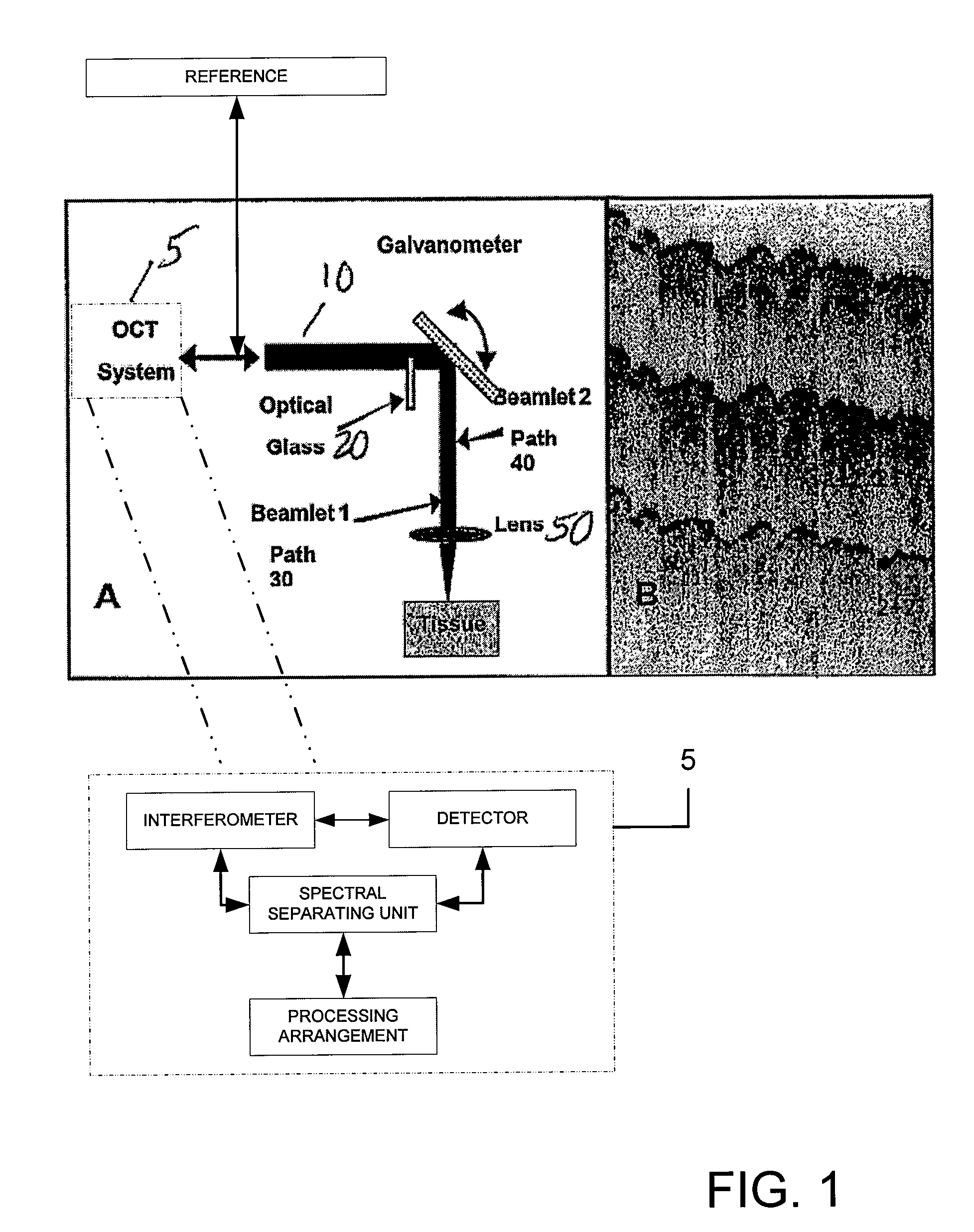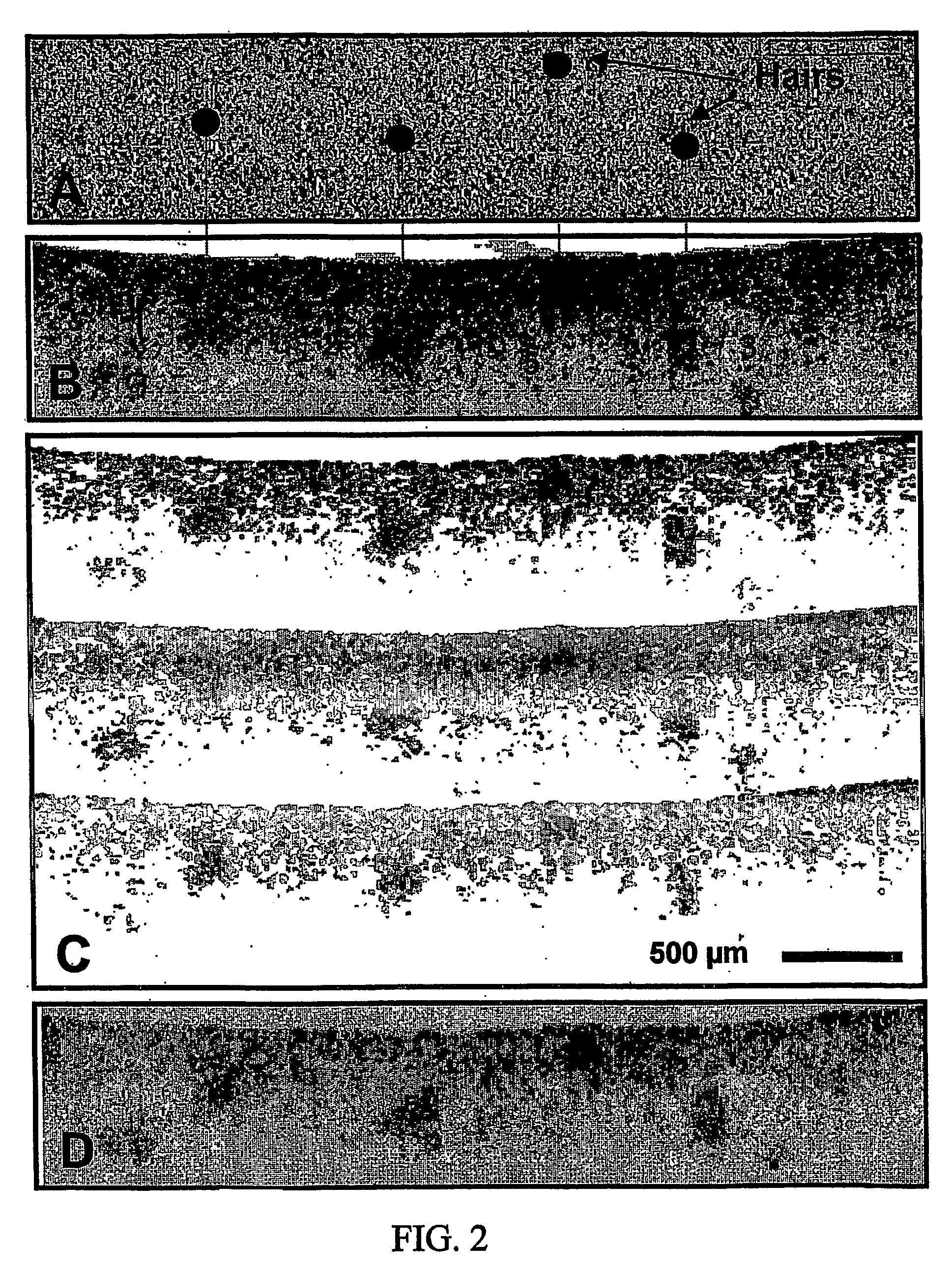Speckle reduction in optical coherence tomography by path length encoded angular compounding
a technology of optical coherence tomography and path length, applied in the field of optical imaging methods and apparatus, to achieve the effect of facilitating a production of at least two radiations
- Summary
- Abstract
- Description
- Claims
- Application Information
AI Technical Summary
Benefits of technology
Problems solved by technology
Method used
Image
Examples
example 1
II. Example 1
[0032]An exemplary polarization-diverse OCT system according to the present invention can be utilized for the examplary apparatus (e.g., as shown in FIG. 1A) that implements ACPE. Using such exemplary system according to the present invention, OCT images may be acquired at 2 frames per second (e.g., 500 axial pixels×500 transverse pixels), which may be displayed with an inverse gray-scale lookup table, and digitally archived. The optical source which can be used in such exemplary OCT system may have a center wavelength of 1310 nm and a bandwidth of 70 nm, and thus providing an axial resolution of approximately 8 μm in the tissue.
[0033]A modified hand-held galvanometer probe (e.g., the apparatus of FIG. 1A) can be inserted in the sample arm of the OCT system 5. The objective lens 50 may have a focal length of 25 mm and a numerical aperture (NA) of 0.11, providing a measured 1 / e2 focal spot diameter of 23 μm. A square, antireflection-coated D=3.1 mm BK7 glass (n=1.51) (e....
example 2
III. Example 2
[0034]A solid phantom consisting of 1% Intralipid solution and Agar can be used to measure a reduction in speckle provided by ACPE. For example, four (4) hairs can be embedded in the Intralipid-Agar gel at different transverse positions and depths. A schematic of the phantom is depicted in FIG. 2A. The corresponding OCT images with and without the BK7 glass plate are shown in FIGS. 2B and 2C, respectively. ROI's labeled 1-5 represent exemplary locations where the SNR improvement by ACPE is preferably measured. The insertion of the BK7 glass plate 20 (with a 3.1 mm BK7 glass element) in the sample arm can produce three copies of the original OCT image (see FIG. 2C), with each image being acquired at a different illumination angles and separated by group delay increments of, e.g., 800 μm. The amplitudes of the signals in the top and bottom images of FIG. 2C can be approximately half of the center image (S1OCT / S2OCT=S3OCT / S2OCT=1:2). The compounded ACPE image shown in FIG...
example 3
IV. Example 3
[0035]In order to demonstrate SNR improvement in vivo, ACPE OCT imaging can be performed on a ventral forearm of a subject. FIGS. 3A and 3B shows one representative set of images. FIG. 3A shows an exemplary OCT image of the ventral forearm obtained in vivo prior to the insertion of the BK7 ACPE element. Visual assessment of these pictures demonstrates a qualitative improvement in the compounded ACPE image (FIG. 3B). The boundary between the epidermis (E) and dermis (D) is more clearly demarcated with ACPE as shown in FIG. 3B. In addition, horizontal structures consistent with dermal vasculature are more readily identified in the ACPE image of FIG. 3B. The SNR can be measured for the ACPE and original OCT images in FIG. 3B, providing an exemplary SNR improvement of 1.56.
[0036]The apparatus and method according to the exemplary embodiments of the present invention are provide to reduce speckle in OCT images that does not decrease the OCT frame rate and requires only minor...
PUM
| Property | Measurement | Unit |
|---|---|---|
| refractive index | aaaaa | aaaaa |
| refractive index | aaaaa | aaaaa |
| thickness | aaaaa | aaaaa |
Abstract
Description
Claims
Application Information
 Login to View More
Login to View More - R&D
- Intellectual Property
- Life Sciences
- Materials
- Tech Scout
- Unparalleled Data Quality
- Higher Quality Content
- 60% Fewer Hallucinations
Browse by: Latest US Patents, China's latest patents, Technical Efficacy Thesaurus, Application Domain, Technology Topic, Popular Technical Reports.
© 2025 PatSnap. All rights reserved.Legal|Privacy policy|Modern Slavery Act Transparency Statement|Sitemap|About US| Contact US: help@patsnap.com



